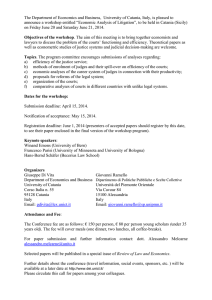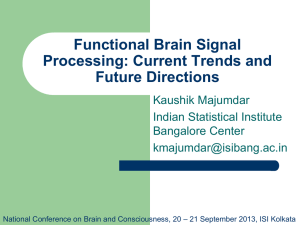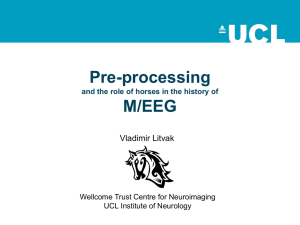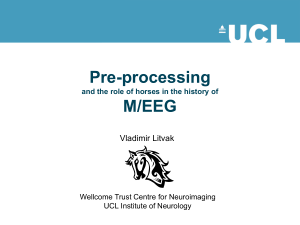«Combining EEG and EMG Signals in a
advertisement
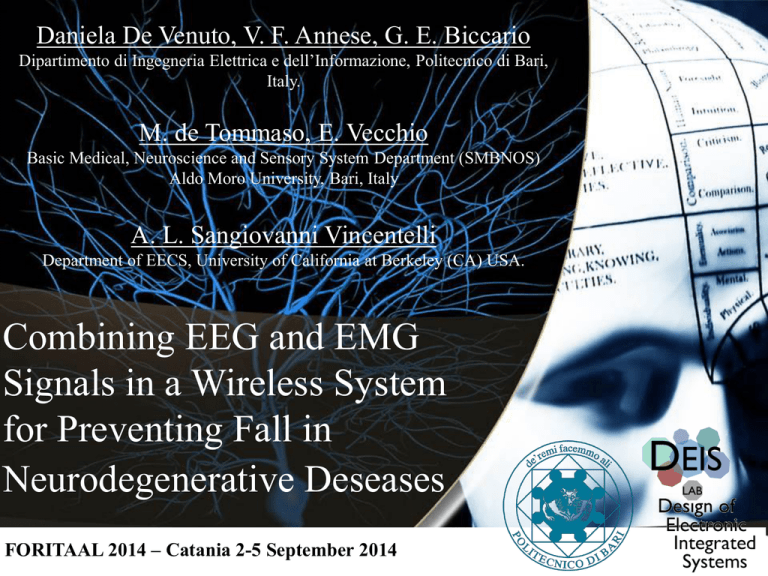
Daniela De Venuto, V. F. Annese, G. E. Biccario Dipartimento di Ingegneria Elettrica e dell’Informazione, Politecnico di Bari, Italy. M. de Tommaso, E. Vecchio Basic Medical, Neuroscience and Sensory System Department (SMBNOS) Aldo Moro University, Bari, Italy A. L. Sangiovanni Vincentelli Department of EECS, University of California at Berkeley (CA) USA. Combining EEG and EMG Signals in a Wireless System for Preventing Fall in Neurodegenerative Deseases FORITAAL 2014 – Catania 2-5 September 2014 Agenda Introduction and Motivations Premotor potential and µ-Rythm EEG and EMG Signal Analysis Wireless System Architecture Conclusions and Future Improvements FORITAAL 2014 - Daniela De Venuto - Catania 2-5 September 2014 The Risk of Fall in Neurodegenerative Deseases Each year, one out of three 65 aged or older adults fall • Main cause of the most common fractures (spine, hip, forearm, leg, ankle, pelvis, upper arm, and hand) • 2010: 2.3 million non-fatal fall injuries among older adults were treated in emergency. • Brain injuries (TBI) • 2010: the medical costs related to falls was $36.4 billion. • Fear of falling that actually increases fall probability • The medical costs prevision for 2020 is $ 61.6 billion. FORITAAL 2014 - Daniela De Venuto - Catania 2-5 September 2014 Premotor Potential (BP) vs µ-Rythm Premotor Potential (BP) • BP is a slow EEG positive component in a time analysis that increases progressively appearing even 1-2s before the voluntary movement onset. • Frequency band : 2-5 Hz • Maximum 100-200ms before the movement beginning • More visible in contralateral hemisphere to limb involved in the movement. µ-Rythm • µ-rhythm, are synchronized patterns of electrical activity involving large numbers of neurons, in the brain area that controls voluntary movement, during a “movement steady state”. • Frequency band 7.5–12.5 Hz (primarily 9–11Hz) • 2 sec before the movement onset FORITAAL 2014 - Daniela De Venuto - Catania 2-5 September 2014 State of the Art No studies in literature report about a WEARABLE, WIRELESS, NON INVASIVE system synchronizing EEG and EMG for fall PREVENTION • Combination of accelerometers and gyroscopes for detecting movements and body position, 300ms before a fall • New inertial sensor can detect fall 700ms before impact. • Brain Computer Interface (BCI) devices for motor imagery use electroencephalograph (EEG) to recognize the beginning of movements • EMG has been studied for artificial limb control in order to increase power strength and, in particular, only after movement is started FORITAAL 2014 - Daniela De Venuto - Catania 2-5 September 2014 EEG and EMG Signal Analysis: SET UP EMG EEG + • 8 Channels • Monitored muscles (both legs): Rectus femoralis, Abductor Femoralis, Gastrocnemius, Tibialis • 256 samples per sec • Gain: ≈ 10 kV ∙ V-1 • Band pass filtered: 1 – 200 Hz • 19 channels ( + reference, + ground) • According to the 10-20 electrodes international standard • 256 samples per sec • Gain ≈ 10 kV ∙ V-1 • Band pass filtered: 1 – 200 Hz FORITAAL 2014 - Daniela De Venuto - Catania 2-5 September 2014 EEG and EMG Signal Analysis: Time Domain Analysis Time domain signals are strongly biased by noise and artifacts (eye movement, head movement, wires movements, etc etc): premotor potential is hard to detect in a realtime approach. F3 Cz C3 Right Tibialis Right Gastrocnemius FORITAAL 2014 - Daniela De Venuto - Catania 2-5 September 2014 EEG and EMG Signal Analysis: Time Domain Analysis Signals are averaged and/or subtracted to better reduce the common noise and to underline the premotion potential FORITAAL 2014 - Daniela De Venuto - Catania 2-5 September 2014 EEG and EMG Signal Analysis: Frequency Analysis FFT in discrete windows of 1 second, show the the different spectral components for the same channel in different conditions: rest (no movements), premotion, motion. The contribution in the 1-5 Hz band is very high one second before the movement: the subject is processing the movement. FORITAAL 2014 - Daniela De Venuto - Catania 2-5 September 2014 EEG and EMG Signal Analysis: Time - Frequency Analysis Time–Frequency analysis for C3-T7 and C3-O2 from subjects doing different tasks: A: resting, B: lifting the right leg, C:balancing on a tilting platform, D: starting a short walk. Presence or absence of mu-rhythm and 2-4 Hz waves are highlighted in orange circle. Red and green signals are respectively EMG and signal considered in timedomain. FORITAAL 2014 - Daniela De Venuto - Catania 2-5 September 2014 Wireless System Architecture: Overview FORITAAL 2014 - Daniela De Venuto - Catania 2-5 September 2014 Wireless System Architecture: WBAN EEG node 868 MHz antenna INA 50 V/V EEGx+ EEGBP Filtering 0,5-100 Hz 100 V/V M u x 12x1 ADC μC RF module 24 Bit 80 ksps EMG node 868 MHz antenna INA 50 V/V EMGx+ EMGxBP Filtering 10-500 Hz 50 V/V M u x μC RF module 8x1 12 Bit 80 ksps FORITAAL 2014 - Daniela De Venuto - Catania 2-5 September 2014 Wireless System Architecture: Receiver 868 MHz antenna Receiver node uController & Processing Unit μC RF module LPF MSK signal LNA 0 90 UMTS module USB module Sampler Th LO Th M u 010… x awg noise N0,i = kT [W/Hz] LPF Sampler Model of the receiver for BER evaluation BER vs SNR in the receiver FORITAAL 2014 - Daniela De Venuto - Catania 2-5 September 2014 Wireless System Architecture: the Wearable Electrodes Printed electrode in gold on Polycaprolactone (PCL) Printed Antenna Gold area for skin contact SMD components implemented using conductiove glue Printing in gold on PCL examples FORITAAL 2014 - Daniela De Venuto - Catania 2-5 September 2014 Wireless System Architecture: Feedback Local Feedback It is possible to avoid the fall through: • • Electro – stimulation Alerting signal External Feedback Fall Prediction FORITAAL 2014 - Daniela De Venuto - Catania 2-5 September 2014 The nearest hospital will be informed of the incident. In this way it is possible an early and optimized intervention Conclusion and Challenges Power Managment Optimize Biofeedback Wearability Dry Electrode Decision Algorithm Optimize Fall Detection FORITAAL 2014 - Daniela De Venuto - Catania 2-5 September 2014 Thanks for your Attention, Questions ? Daniela De Venuto, Politecnico di Bari, Dep. of Electronics and Informatic Engineering Email: daniela.devenuto@poliba.it FORITAAL 2014 - Catania 2-5 September 2014
